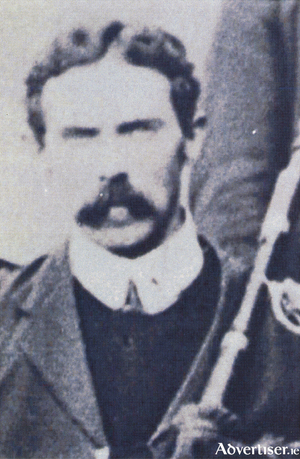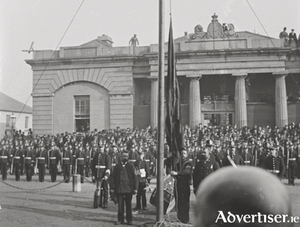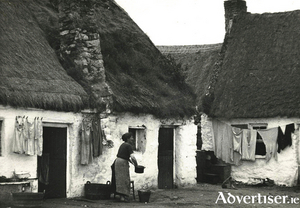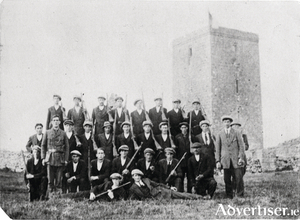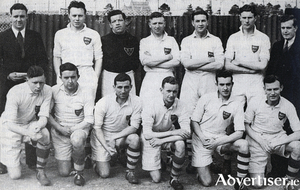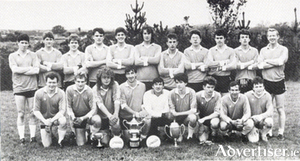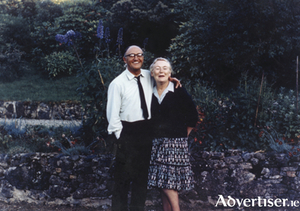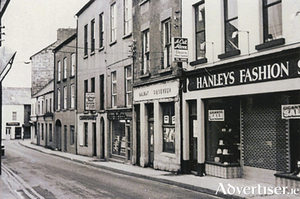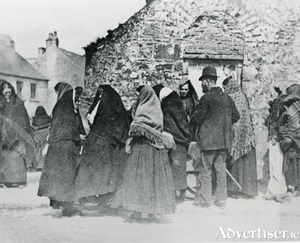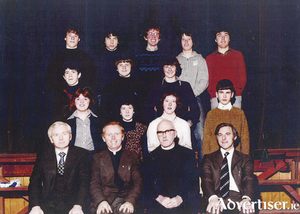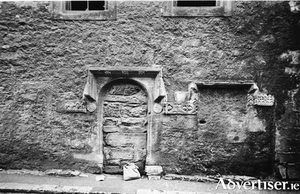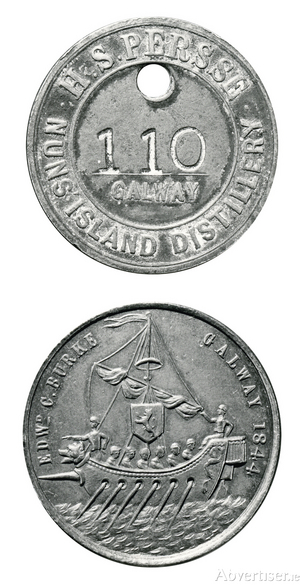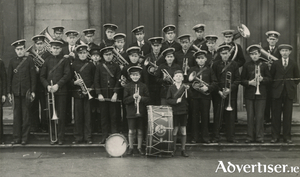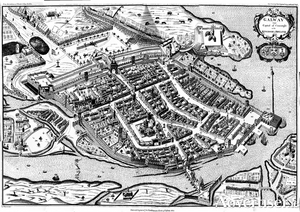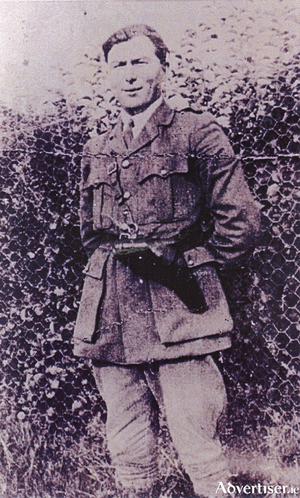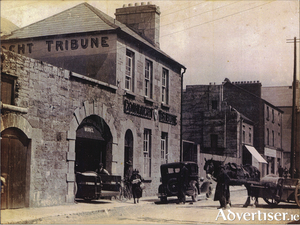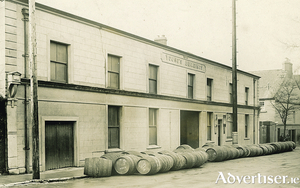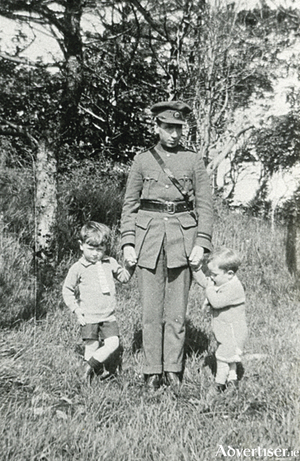Seamus Carter, athlete, Gaeilgóir, patriot
Thu, Feb 18, 2016
Seamus Carter was a fluent Irish speaker who was a member of the Gaelic League since its inception. He was the secretary of the Oireachtas when it was held in Galway in 1913, the famous photograph of which hangs in the Town Hall.
Read more ...The Proclamation Of King George V
Thu, Feb 11, 2016
“The accession of His Majesty King George V was proclaimed in Galway at 2 o’clock on Saturday (21st of May, 1910). The ceremony was performed by the High Sherriff, Mr. Cecil R. Henry, and took place opposite the Courthouse. On the steps of the building there was a fashionable gathering. Outside the hollow square formed by soldiers and police, the crowd was one of immense proportions. About one hundred men of the Connaught Rangers, with their band and the King’s colour, under Major Sarsfield, were formed up in line opposite the Courthouse, and an equal number of the Royal Irish Constabulary, drawn from Galway and outside stations, filled up the remaining sides of the square. They were in charge of Co. Inspector Flower, Districts-Inspectors Mercer and O’Rorke.
Read more ...Wash day in The Claddagh
Thu, Feb 04, 2016
“With its old houses — straw for their roofs and rock and mortar for their walls, and every little end of a wall whitewashed a hundred times in blue or white or thin pink — the Claddagh was lovely, and from a distance it did the eye good. It was quaint, of course, but also a home-like little village; it had sand for its walks and a turfy marlish stuff for its floors, and always curls of smoke from its square low chimneys.
Read more ...The First Galway Brigade, 2nd Battalion
Thu, Jan 28, 2016
During the War of Independence, the Volunteers, for organisational purposes, divided the country into divisions. Connacht and County Clare were split into four such sections. In each of these, the members were divided into brigades, battalions, companies, and flying columns. The First Galway Brigade was divided into three battalions, Castlegar, Claregalway, and Headford.
Read more ...GALWAY c1200 to c1900
Fri, Jan 22, 2016
The above is the title of a newly published folding map by the Royal Irish Academy. It has been compiled by Jacinta Prunty and Paul Walsh using the extensive topographical information which they collected while working on a forthcoming book entitled Galway in the Historic Towns Atlas series. They also studied old maps of the city. This map extends from Newcastle Road to College Road and from Terryland to Nimmo’s Pier. The map and its extensive indices are unrivalled in their detail and afford a unique window into the earlier medieval topography and way of life in the city.
The heavy black line represents the old walls of Galway superimposed on a current ordinance map of the city centre. The various symbols we see are all described on the index to the map and also dated. So, for example E30 is listed as a ‘Meal and Flour Mill, 1656’.
Read more ...FAI Junior Cup finalists 1941
Thu, Jan 14, 2016
John O’Dowd was a Galway born printer who went to work in Kilkenny and became involved with the formation of a junior soccer league in the area. In 1931, his widowed sister, Mrs Brigid Mulryan from Woodquay, died and left four children. John gave up his Kilkenny job and returned to Galway to mind the children. He worked for a while in the Connacht Tribune and later in the Galway Printing Company.
Read more ...West Board Junior Champions 1989
Fri, Jan 08, 2016
Barna had a hurling team in 1964 and handball was very popular in the area, but anyone wanting to play football would have togged out for An Spidéal. Local games were played in Sean Lydon’s field along the shorefront, halfway between the church and Barna school. Kevin Curran and Nicholas O’Fegan were the founders of Barna GAA Club in 1965 and they managed to field minor and junior teams that year. Their junior team had the honour of playing the club’s first competitive match on May 30 1965 against a Bohermore selection known as John F Kennedy’s. Kennedy’s won by a point.
Read more ...'Pat The Boat' a poem by Walter Macken
Wed, Dec 30, 2015
As we come to the end of the Walter Macken centenary, we thought it appropriate to reprint the only known piece of poetry that he wrote. It was first printed in 1963 in Criterion, a UCG magazine that was edited by Kevin Brophy at the time. It is homage, ómós if you like, to an old fisherman and reflects Macken’s love of fishing, of the Corrib, and of his understanding of people. The photograph of himself and his wife Peggy was taken in the garden of their home Gort na Gainiv near Oughterard c1960.
Read more ...George Nicholls, Rising organiser and volunteer
Thu, Dec 17, 2015
George Nicholls was a young solicitor who worked in G.C. Conroy’s office in Francis Street. In 1912, he set up a pipe band known as “Cumann Píobairí naGaillimhe”, the only band with an Irish language name to play at O’Donovan Rossa’s funeral to which they travelled in the company of Padraic Pearse.
Our photograph was taken that year. Nicholls was the nerve centre for the IRB in Galway. He later became the town coroner. In December 1913 he was involved in setting up a large public meeting in the Town Hall for the purpose of starting the Volunteers in Galway. Mairtín Mór McDonogh was in the chair and the speakers were Roger Casement and Eoin McNeill.
Read more ...Upper Abbeygate Street c1978
Thu, Dec 10, 2015
An old Galwegian gave us this photograph of Upper Abbeygate Street as seen from the corner of Market Street. In the late 1940s the building we see down at the end on the corner of Mary Street was Tommy Hopkins, victuallers. Opposite that, at the time, at the end of Abbeygate Street was Mrs Kemple’s house. Next door was Paul Heaney’s butcher shop; Moloney’s sweet shop; Barrett’s, Mrs Barrett had a cake making business; the Shapiros lived next door, and beside their house was an archway that led in to the back of the house; Ellie Carter and her brother were next; then Miko Cunningham’s sweet shop where he sold groceries as well. The next building was known as Carter’s Halls and among those who lived there were Mick Tuite, who was known only as ‘Shoots’, the Haynes family, Mary Anne O’Toole, Michael Melia, Chrissie Melia, Rose Anne Melia (these were Mary Anne’s children), Anthony Morris, Julia Murphy, Lizzie Hehir, Martin Cunniss, and Molly Hosty and her daughter.
Read more ...The egg and butter market in Woodquay
Thu, Dec 03, 2015
This photograph was taken about the year 1900 and shows part of the market at the corner of Woodquay and Eyre Street. The derelict gable we see in the background was later developed as Creaven’s boot shop. It was subsequently occupied by O’Connor TV, then became a florists run by Brian O’Malley, and today is Richard Hughes’ opticians.
Read more ...The first co-ed class in the Jes
Thu, Nov 26, 2015
St Ignatius College’ on Sea Road opened its doors for the first time in 1862. The Jesuits built a residence and a church at the same time and the move proved to be a success for them. Attendances at Mass and ceremonies grew rapidly. The college, however, was more of a challenge. The boys ranged in age from nine to 13 and the subjects taught included mathematics, Latin, Greek, and elocution. The numbers at first were as expected. They grew steadily to 90 in 1865 and reached 110 by 1874, but they began to fall thereafter and were inconsistent from year to year. The number recorded for 1899 was 49.
Read more ...The Athy Doorway
Thu, Nov 19, 2015
The Athy family are of great antiquity in Galway. They were originally Anglo-Norman, but on coming here, they quickly became one of the original Tribes. Their estates were mainly in the Oranmore area, they owned the Rinville Estate. They are credited with being the first family to erect a stone building in the city in the 13th century. Castles associated with the family through the years are Ballylee, Carrigín, Glinsk, Castletown, Rinville, Claregalway, Ardmullivan, De Bermingham’s, Aughnanure, and Castledaly.
Read more ...Galway Distillery tickets
Thu, Nov 12, 2015
In the 1600s trade tokens were given out by the Crown and were used as a royal licence to do business. If you were a trades or business merchant, you had to obtain this token. Some had dates on them and some had not. In Galway city and county there were 43 merchants listed in the period 1653-1679. By 1680, many of these tokens were replaced by the halfpenny copper coin.
Read more ...St Patrick's Brass Band
Thu, Nov 05, 2015
If you think Saint Patrick’s Brass band seems to have been around forever, you are almost right. It was founded 119 years ago in 1896, in Forster Street by Peter Rabbitte, Michael Spelman, and Paddy Walsh. It was originally a fife and drum band known as St Patrick’s Fife and Drum Band Society.
Read more ...Lecture on the people who ran 17th century Galway
Thu, Nov 05, 2015
The men who controlled Galway city and its corporation in the 17th century, had wealth and power, but they had to tread carefully with English dominance and sectarianism breathing down their necks.
Read more ...Thomas ‘Baby’ Duggan
Thu, Oct 29, 2015
Thomas Duggan was popularly known as “Baby” because of the contrast to his considerable proportions. He was born in 1899. Although only a boy, he was one of the first to take up arms with Liam Mellows in the lead up to the Rising. When the Rising was quelled, he was arrested with many others and interned at Frongoch. He was kept there until Christmas, when he was released under a general amnesty.
Read more ...Local papers and their role in our history
Thu, Oct 22, 2015
In 1909 Galway was at a low ebb, the population was just over 3,000, the local economy was in poor shape, the canal and the docks were not being well used commercially, the student population of UCG was 131, there was very little manufacturing, and local politics was still bedevilled by the Parnell split. There were two local newspapers, The Connacht Champion which actively supported William Smith O’Brien MP and often virulently attacked the Irish Parliamentary Party, and The Galway Express which originally supported the conservative unionist viewpoint, but which gradually became more nationalist until its premises were wrecked in 1920 by the Black and Tans.
Read more ...Joe Young’s ‘Windy Waters’
Thu, Oct 15, 2015
James Hardiman, in his history of Galway, mentions a spring well that was reputedly 1,000 years old. He described it as “A Chalybeate spring of the same class as the celebrated Scarborough Waters, outside the East Gate was in great repute here. A spa house has been erected over it by a Mr. Eyre (who sailed with Columbus when America was discovered) and is much frequented.” Hardiman attributed to the tonic qualities of the water the numerous instances of longevity which he observed in the district.
Read more ...Mícheál Ó Droighneáin, 1916 veteran
Thu, Oct 08, 2015
Mícheál Ó Droighneáin was born in Spiddal. He left school when he was 14 and got a job in McCambridge’s for 6d a week. Lady Killanin convinced him to go back to school and he became a monitor, went on to training college in Dublin, and it was there he became a Nationalist. “I became a member of the IRB towards the end of 1910 when I was teaching in Dublin [from August 1910 to January 1913]. Then I came to my native place, teaching in Spiddal for one year and then coming to Furbo.”
Read more ...